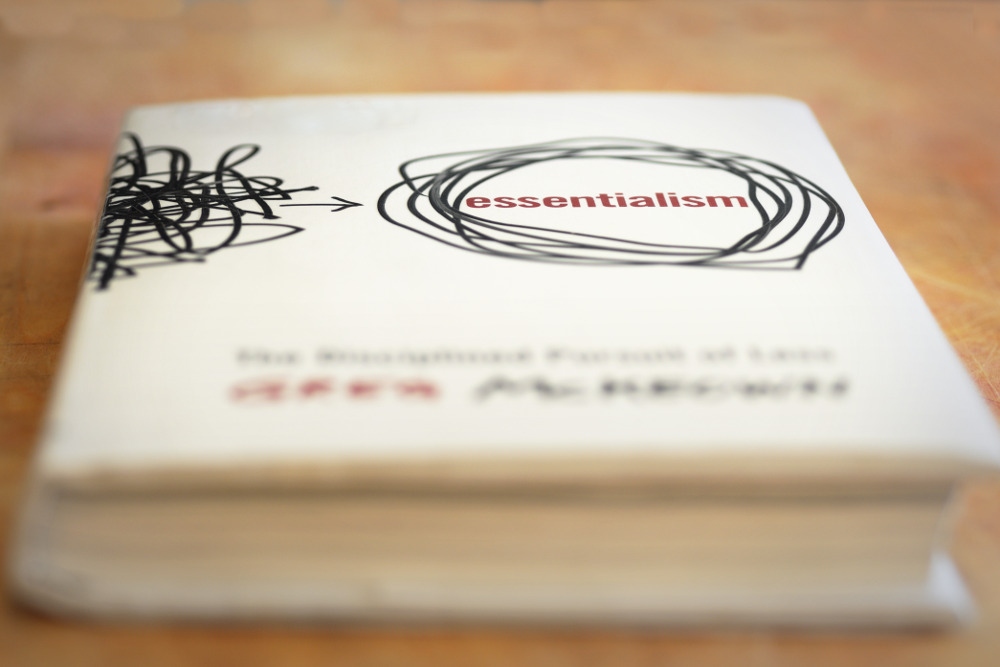
I recently read the book Essentialism: The Disciplined Pursuit of Less, by Greg McKeown. To vastly simplify it: time is a finite resource, spend it well. As I read it, I was struck by how this book’s philosophy and recommendations translate darn near exactly into effective financial planning.
Essentialism, the Book
To elaborate (only slightly) on my above synopsis, this book says:
- There are many more choices in this world than we have time to pursue.
- Modern communication, especially social media (ubiquitous, easy, and instant), throws it in our faces that other people are pursuing these other choices.
- We feel as if we need to pursue all of them ourselves.
- And so we try. And we fail. And we’re miserable.
The solution? Give yourself time to think about what’s important to you and what you want to accomplish. In your job, in your personal life, in your community. Then say “No” (literally or figuratively) to everything that doesn’t help support those values or get you closer to those goals. In other words, do less, but better.
I really do recommend you read the book (I got my copy from the library). Nothing will be earth-shattering: we already know we feel like chickens with our heads cut off and, at some level, what we need to do to combat that. But as with most things, we need a regular (and in this case, concise and compelling) reminder of what we should be doing.
Essentialism, as Applied to Financial Planning
It’s an easy and inspiring read, so I’m not going to review it anymore than I have. What this post delves into are the parallels that jumped out at me between the tenets of Essentialism and those of effective financial planning.
The Steps of “Essentialist” Financial Planning
Step 1. Give yourself time to think about what you really want. There are two important elements here: time and you.
Time. Though you certainly don’t need a financial planner to do these things, it helps. If not a financial planner, either a crazy amount of self-discipline or another person (a therapist, a support group, a friend you’re doing a personal finance project with… I’m talking about you, Jen Alonzo!) who can hold you accountable.
You. This requires you to be honest with yourself about what you want, what your values are, what your goals are. Where are your dollars best spent? On vacations? On philanthropy? On taking time off from work in the middle of your career? On private school? On enabling yourself to start a new business <cough>?
Step 2. Make a plan. All those namby pamby goals and values you just thought through? Make them concrete and Write Them Down.
2 weeks in Hawaii every winter (who me, living in the Pacific Northwest? Why ever would you ask?), retiring at age 55, taking 1 year off from work in 4 years so you can take the kids around the country, putting Little Susy in the local Waldorf school, etc. Put dollar values, dates, and other quantifiable, measurable details against each goal and value.
Though the book doesn’t talk much about the value of writing this stuff down, I find in my personal and professional lives that Sh*t Just Got Real when you put pen to paper.
Step 3. Evaluate the (innumerable) options against this framework. Opportunities to spend your dollars will arise. Pretty much all day every day. Now you have a way of quickly evaluating what you should do with those opportunities.
As the book says,
If it’s not a clear yes, then it’s a clear no.
(I love love love this concept. Such a pithy, easy mnemonic for making decisions.) This is the hard part. This involves saying No. Not pursuing opportunities. All the time.
So your friend went to France last summer and posted all those awesome pictures of croissants and quaint cafes and the Eiffel Tower all over Facebook. That sounds So Awesome. And it is! In a perfect world, we have all the time and money we want (now that I say that, I’m not actually so sure that would be “perfect,” but I digress). But we have limited amounts of both, so you decide to instead spend your vacation time and money on that Hawaii trip instead. Do less, but better.
Step 4. Circle back. Circumstances change. Life marches on. Regularly give yourself time to think about the highest, best use of your money and whether your actions are still reflecting that choice.
Investing, Too
This approach absotively applies to investing also. It is, in fact, the essence of effective investing!
Step 1. As I’ve said before in this blog (here and here, and oh, here), first you need to think about what goals you want your investing to help you achieve. Not “I want lots of money!” or “I want to beat the market!” But instead “I want to send my child to college without debt” or “I want to buy a house in 5 years.”
Step 2. Then you make an investment plan with an asset allocation and specific investments that have the best chance of getting you towards those goals. You make this plan in calm, rational times.
Step 3. Then when opportunities arise to make changes to your portfolio (which is to say, all the time, but especially during market turmoil), you have this framework against which to evaluate the options available to you. And let me tell you, when it comes to investing, “if it’s not a clear yes, it’s a clear no” couldn’t be more applicable.
Step 4. Especially as time marches on, focus changes. You’ve paid off your student loans and now you are thinking of having a baby. Or now you’re starting to focus on retirement. Or now you’re just plain older. The investment plan needs to reflect those shifts. An annual review of your investment plan usually suffices to make sure you’re keeping your investment plan in
Other Essentialism Concepts that Will Help Along the Way
Recognize that there are trade-offs. Just as an Essentialist recognizes that by spending an hour at work, she can’t spend that hour with her child, if you have $5000 and you want both a $5000 vacation now and to retire a bit earlier, you can’t do both with that $5000. Don’t try to cheap out on both things. Choose the one that better aligns with the values and goals you’ve already thought through and enjoy it to the max. Do less, but better.
“The Power of Small Wins.” In my practice, I start a relationship with a comprehensive financial analysis that, yes, can sometimes produce a laundry list of recommendations. But, and here’s the important part, I choose two and ask the client to do these first. We’ll get to the rest in due time.
Prepare (or, “create a buffer”).
The reality is that we live in an unpredictable world. … Therefore, we can either wait for the moment and react to it or we can prepare. We can create a buffer.
This means two things to me: risk management, and starting financial planning early.
Risk management means having an emergency fund that can carry you through at least 3 months, insurance to replace your income in case you no longer earn it, a will that designates a guardian for your child, etc.
I really admire my very first client, a couple in their mid-20s whose futures are bright. They sought me out not because anything was wrong with their finances but because they wanted to ensure that they have the right infrastructure set up in their financial life so they know they’re making the best use of their money and opportunities.
Preparation gives you options, as I’ve talked out before.
Be Intentional. This is the tenet that speaks most loudly to me, in all realms of life. Just as this book encourages you to be intentional in how you use your time, I want you to be intentional in how you use your money.
That’s what you accomplish by giving yourself time to think about what you want and then evaluating all your options against that framework. No more blindly making decisions because you’re too tired or the thought process is too daunting.
How do you take time to think about what’s most important to you, out of the world of possibilities? When have you said “No” to an objectively cool/interesting/good thing because it didn’t align with your goals?
I’m no best-selling author, but I can help you craft a simple, effective, values-driven financial plan. You can stop worrying, and take comfort in knowing that your money is going to its highest and best use. If this approach to financial planning resonates with you, reach out to me at or schedule a free 30-minute consultation.
Sign up for Flow’s Monthly Newsletter to effortlessly stay on top of my blog posts and extra goodies, and also receive my Guide to Optimizing Your Stock Compensation for free!
Disclaimer: This article is provided for general information and illustration purposes only. Nothing contained in the material constitutes tax advice, a recommendation for purchase or sale of any security, or investment advisory services. I encourage you to consult a financial planner and/or an accountant for advice specific to your situation. Reproduction of this material is prohibited without written permission from Meg Bartelt, and all rights are reserved. Read the full Disclaimer.



